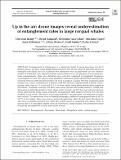Files in this item
Up in the air : drone images reveal underestimation of entanglement rates in large rorqual whales
Item metadata
| dc.contributor.author | Ramp, C | |
| dc.contributor.author | Gaspard, D | |
| dc.contributor.author | Gavrilchuk, K | |
| dc.contributor.author | Unger, M | |
| dc.contributor.author | Schleimer, A | |
| dc.contributor.author | Delarue, J | |
| dc.contributor.author | Landry, S | |
| dc.contributor.author | Sears, R | |
| dc.date.accessioned | 2021-02-15T17:30:09Z | |
| dc.date.available | 2021-02-15T17:30:09Z | |
| dc.date.issued | 2021-01-28 | |
| dc.identifier | 272795482 | |
| dc.identifier | 7b1ec3b3-41b6-48d0-b7f7-921f67f7a998 | |
| dc.identifier | 85101052124 | |
| dc.identifier | 000649277100003 | |
| dc.identifier.citation | Ramp , C , Gaspard , D , Gavrilchuk , K , Unger , M , Schleimer , A , Delarue , J , Landry , S & Sears , R 2021 , ' Up in the air : drone images reveal underestimation of entanglement rates in large rorqual whales ' , Endangered Species Research , vol. 44 , pp. 33-44 . https://doi.org/10.3354/esr01084 | en |
| dc.identifier.issn | 1863-5407 | |
| dc.identifier.other | Jisc: 4efafd040a0c4605a56ac3d41892b295 | |
| dc.identifier.other | ORCID: /0000-0002-9798-5074/work/88731512 | |
| dc.identifier.uri | https://hdl.handle.net/10023/21437 | |
| dc.description | Funding: The aerial part of the study in 2018 and 2019 was funded by DFO. | en |
| dc.description.abstract | Entanglement in fishing gear is a significant threat to many cetaceans. For the 2 largest species, the blue whale Balaenoptera musculus and the fin whale B. physalus, reports of entangled individuals are rare, leading to the assumption that entanglements are not common. Studies of interaction with fisheries in other species often rely on the presence of scars from previous entanglements. Here, scar detection rates were first examined in humpback Megaptera novaeangliae, fin and blue whales using standard vessel-based photo-identification photographs collected between 2009 and 2016 in the Gulf of St. Lawrence, Canada. We then examined aerial images of fin whales collected with a drone in 2018 and 2019 and compared both methods. Entanglement rates were 6.5% for fin and 13.1% for blue whales using photo-identification images of individuals. Prominent scarring was observed around the tail and caudal peduncle, visible only when animals lifted those body sections above water when diving. For the small subset of pictures which captured the entire caudal peduncle, entanglement rates ranged between 60% for blue and 80% for fin whales. This result was similar to the 85% entanglement rate estimated in humpback whales. The assessment of aerial-based photography yielded an entanglement rate of 44.1 to 54.7% in fin whales. Scars were always around the peduncle, often the tail, rarely the dorsal fin and never around the pectoral fins, while the mouth cannot be examined from above. Thus, in species that do not regularly expose their tail or peduncle, aerial imagery is the preferred method to quantify entanglement rates by assessment of scars. | |
| dc.format.extent | 12 | |
| dc.format.extent | 4689981 | |
| dc.language.iso | eng | |
| dc.relation.ispartof | Endangered Species Research | en |
| dc.subject | Entanglement | en |
| dc.subject | Fin whale | en |
| dc.subject | Blue whale | en |
| dc.subject | Humpback whale | en |
| dc.subject | Aerial imagery | en |
| dc.subject | QL Zoology | en |
| dc.subject | DAS | en |
| dc.subject | NIS | en |
| dc.subject | MCC | en |
| dc.subject.lcc | QL | en |
| dc.title | Up in the air : drone images reveal underestimation of entanglement rates in large rorqual whales | en |
| dc.type | Journal article | en |
| dc.contributor.institution | University of St Andrews. School of Biology | en |
| dc.contributor.institution | University of St Andrews. Arctic Research Centre | en |
| dc.identifier.doi | https://doi.org/10.3354/esr01084 | |
| dc.description.status | Peer reviewed | en |
This item appears in the following Collection(s)
Items in the St Andrews Research Repository are protected by copyright, with all rights reserved, unless otherwise indicated.

